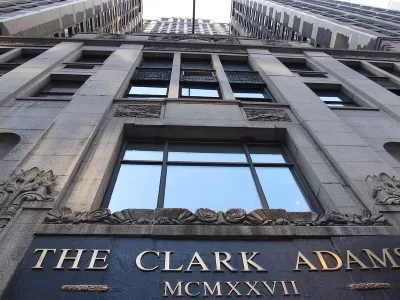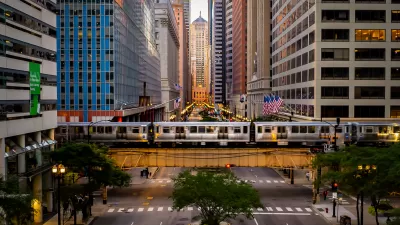In Chicago, a developer plans to convert 31 floors of a commercial building in Chicago into space for 505 co-living residents.

"A Chicago developer plans to bring 505 co-living residents to a 41-story Loop office tower, the largest communal living property ever proposed in the city," reports Ryan Ori.
"CityPads has a deal to buy the top 31 floors of the 92-year-old Clark Adams Building, with plans to invest $80 million converting the office space into small, shared apartments that will be managed by co-living firm Common," adds Ori.
In addition to spreading 505 beds around shared rooms, with three or four beds each, the co-living development will include 159 traditional apartments with a total of 172 beds.
The context for the development news includes a struggling office market, which is facing a growing number of vacancies in the Central Loop.
FULL STORY: Loop office tower to become largest communal living property ever proposed in Chicago

Planetizen Federal Action Tracker
A weekly monitor of how Trump’s orders and actions are impacting planners and planning in America.

Maui's Vacation Rental Debate Turns Ugly
Verbal attacks, misinformation campaigns and fistfights plague a high-stakes debate to convert thousands of vacation rentals into long-term housing.

Restaurant Patios Were a Pandemic Win — Why Were They so Hard to Keep?
Social distancing requirements and changes in travel patterns prompted cities to pilot new uses for street and sidewalk space. Then it got complicated.

In California Battle of Housing vs. Environment, Housing Just Won
A new state law significantly limits the power of CEQA, an environmental review law that served as a powerful tool for blocking new development.

Boulder Eliminates Parking Minimums Citywide
Officials estimate the cost of building a single underground parking space at up to $100,000.

Orange County, Florida Adopts Largest US “Sprawl Repair” Code
The ‘Orange Code’ seeks to rectify decades of sprawl-inducing, car-oriented development.
Urban Design for Planners 1: Software Tools
This six-course series explores essential urban design concepts using open source software and equips planners with the tools they need to participate fully in the urban design process.
Planning for Universal Design
Learn the tools for implementing Universal Design in planning regulations.
Heyer Gruel & Associates PA
JM Goldson LLC
Custer County Colorado
City of Camden Redevelopment Agency
City of Astoria
Transportation Research & Education Center (TREC) at Portland State University
Jefferson Parish Government
Camden Redevelopment Agency
City of Claremont





























